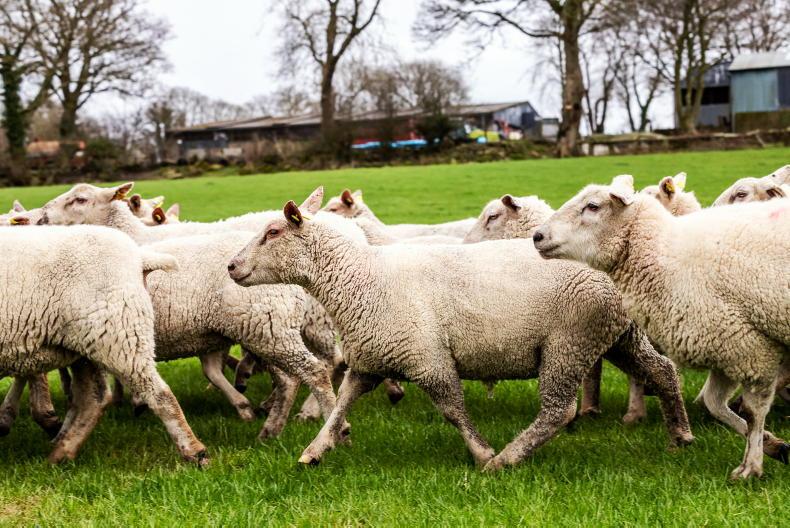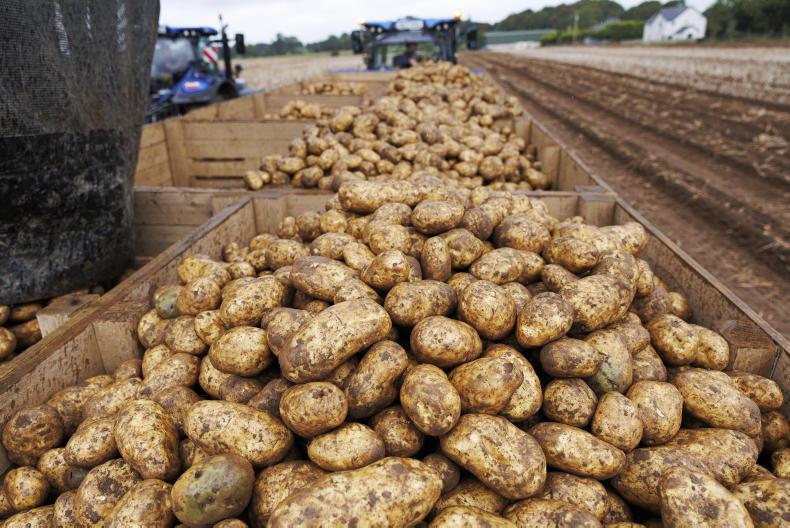The first attempt to establish clover into dairy paddocks at CAFRE’s Greenmount campus ended up with half of the area doing really well, and the other half being “a bit of a flop”, CAFRE dairy technologist Robert Patterson has said.
Addressing a webinar last Thursday organised by AgriSearch, CAFRE and AFBI, which looked at how farmers can improve nutrient use efficiency this year, Patterson outlined the work done to establish clover on one-sixth of the main 36ha grazing block at the campus.
He emphasised that timing is critical in clover establishment, with the plant requiring soil temperatures above 8°C, adequate soil moisture and long daylight hours.
A cut-off date of 1 June was chosen to avoid any soil moisture deficit in June and July, and shorter days in July and August.
Given limited availability of clover-safe sprays, the three paddocks had low weed burdens and were at optimum levels for fertility, with soil pH of 6.3 and phosphorus (P) and potassium (K) indexes at 3.
The clover was broadcast in the week beginning 23 May using a spring tine harrow fitted with an air seeder, with the tines angled up as much as possible to minimise soil disturbance for fear of germinating weeds.
Pre-sowing, one of the paddocks had a cover of 3,000kg of grass dry matter per hectare (DM/ha). It was pre-moved before grazing, with the seed applied after cows were removed. The other two paddocks had 4,000kg DM/ha which was baled before clover was sown.
Each paddock received 2.5kg per acre of the medium leaf variety Aberdai, along with a small amount of prilled lime and muriate of potash (0.0.60). Paddocks were then rolled.
To help prevent grass out-competing clover seedlings the paddocks were then grazed every 18 to 21 days, with cows going in at lower than normal grass covers of 2,400 to 2,600kg DM/ha. No nitrogen (N) was sown after the first grazing, but beyond that, a half rate of 13kgN/ha (less than half a bag of CAN/acre) was applied in three subsequent grazing rotations. The paddocks were mob-grazed by sheep in November.
Clover content
While 3ha has a good covering of clover, “it didn’t all go to plan” said Patterson, with the other 3ha with very little clover apparent. He suggested that the paddocks baled beforehand had quite a lot of dead material in the base of the sward, so it might have been necessary to stitch in the clover rather than broadcast the seed.
“It’s a slow and long process that needs to be chipped away at every year,” he maintained, adding that another 6ha is to be tried this spring.
On the 3ha that has a good cover of clover, the plan is to go with 26kg of N/ha for the first two grazings, and a half rate of 13kg thereafter. In total, it will mean fertiliser N is reduced by 100kg/ha.
That runs contrary to advice given at an AgriSearch event on clover in December 2022 when farmers were told not to apply N to clover swards.
“The more N you put on, the less N you are going to fix,” acknowledged Patterson. “It’s a trade-off. We are still trying to maintain a high level of grass production. We are maybe playing it a bit safe,” he said.
Two-thirds of soils below
target pH
Ahead of up-to-date results coming from Zone 1 of the soil nutrient health scheme, the current best estimate is that around 64% of soils in NI are below the optimum pH of 6, CAFRE adviser Aveen McMullan told last Thursday’s event.
During her presentation she warned farmers not to think a pH of 5.8 “is close enough”, explaining that in reality it often means a range of 5.4 to 6.2 across a field.
Where soil pH is low, various key nutrients including nitrogen (N), phosphorus (P) and potassium (K) are less available for uptake by the plant. To illustrate the point, McMullan compared fertiliser uptake where soil is at pH 6 to 6.5 versus when it is 5 to 5.5. If 150kg N/ha in the form of 27.4.4 (priced at £730/t) is applied across the season (approx 11 bags per acre), up to £129 worth of fertiliser is effectively lost in the more acidic soil.
Nutrient plan
During her presentation she also urged farmers to use results of soil analysis as the basis for a nutrient management plan. To assist the process, a crop nutrient calculator is available at DAERA online services. For farmers in Zone 1 of the soil scheme, this online tool will be pre-populated with their data in the coming weeks.
No yield gain from liquid nitrogen
The results of two trials at AFBI suggest there is little overall difference between granular and liquid nitrogen (N) products when applied at the same rate over the course of the growing season.
Explaining the results at last Thursday’s webinar, Dr Suzanne Higgins acknowledged that the data is limited, and a new trial is starting this year comparing various N fertilisers.
In the initial work, AFBI was asked by a commercial company to assess granular and liquid N products including two liquid products containing the plant growth hormone, gibberellin.
This hormone is designed to boost early spring growth, and that was seen in the results.
In the first cut of grass three weeks after a single dose of N was applied, the products containing gibberellin produced significantly higher yields.
However, the effect did not persist, and at subsequent cuts, granular fertilisers outperformed the liquid alternative.
In a second trial, four weeks was left before cutting, and by this stage the granular fertiliser produced higher yields.
“This is very limited work that we have done. Be careful what you are buying and look at what it is designed to do. Liquid products are taken up very quickly, but once gone there is very little residual N left in the soil,” said Higgins.
Foliar feeds
Liquid fertiliser is different to biostimulants and foliar feeds which require leaf to be available for plant uptake.
During her presentation, Aveen McMullan suggested foliar feeds do have a place if used correctly, but warned the market is unregulated. “Ask for a label, ask for an analysis and ask some questions, rather than just taking their word that it is good for the crop,” she advised.
Read more
Lower GHG emissions and higher profit with clover
Mindset change with multispecies swards
The first attempt to establish clover into dairy paddocks at CAFRE’s Greenmount campus ended up with half of the area doing really well, and the other half being “a bit of a flop”, CAFRE dairy technologist Robert Patterson has said.
Addressing a webinar last Thursday organised by AgriSearch, CAFRE and AFBI, which looked at how farmers can improve nutrient use efficiency this year, Patterson outlined the work done to establish clover on one-sixth of the main 36ha grazing block at the campus.
He emphasised that timing is critical in clover establishment, with the plant requiring soil temperatures above 8°C, adequate soil moisture and long daylight hours.
A cut-off date of 1 June was chosen to avoid any soil moisture deficit in June and July, and shorter days in July and August.
Given limited availability of clover-safe sprays, the three paddocks had low weed burdens and were at optimum levels for fertility, with soil pH of 6.3 and phosphorus (P) and potassium (K) indexes at 3.
The clover was broadcast in the week beginning 23 May using a spring tine harrow fitted with an air seeder, with the tines angled up as much as possible to minimise soil disturbance for fear of germinating weeds.
Pre-sowing, one of the paddocks had a cover of 3,000kg of grass dry matter per hectare (DM/ha). It was pre-moved before grazing, with the seed applied after cows were removed. The other two paddocks had 4,000kg DM/ha which was baled before clover was sown.
Each paddock received 2.5kg per acre of the medium leaf variety Aberdai, along with a small amount of prilled lime and muriate of potash (0.0.60). Paddocks were then rolled.
To help prevent grass out-competing clover seedlings the paddocks were then grazed every 18 to 21 days, with cows going in at lower than normal grass covers of 2,400 to 2,600kg DM/ha. No nitrogen (N) was sown after the first grazing, but beyond that, a half rate of 13kgN/ha (less than half a bag of CAN/acre) was applied in three subsequent grazing rotations. The paddocks were mob-grazed by sheep in November.
Clover content
While 3ha has a good covering of clover, “it didn’t all go to plan” said Patterson, with the other 3ha with very little clover apparent. He suggested that the paddocks baled beforehand had quite a lot of dead material in the base of the sward, so it might have been necessary to stitch in the clover rather than broadcast the seed.
“It’s a slow and long process that needs to be chipped away at every year,” he maintained, adding that another 6ha is to be tried this spring.
On the 3ha that has a good cover of clover, the plan is to go with 26kg of N/ha for the first two grazings, and a half rate of 13kg thereafter. In total, it will mean fertiliser N is reduced by 100kg/ha.
That runs contrary to advice given at an AgriSearch event on clover in December 2022 when farmers were told not to apply N to clover swards.
“The more N you put on, the less N you are going to fix,” acknowledged Patterson. “It’s a trade-off. We are still trying to maintain a high level of grass production. We are maybe playing it a bit safe,” he said.
Two-thirds of soils below
target pH
Ahead of up-to-date results coming from Zone 1 of the soil nutrient health scheme, the current best estimate is that around 64% of soils in NI are below the optimum pH of 6, CAFRE adviser Aveen McMullan told last Thursday’s event.
During her presentation she warned farmers not to think a pH of 5.8 “is close enough”, explaining that in reality it often means a range of 5.4 to 6.2 across a field.
Where soil pH is low, various key nutrients including nitrogen (N), phosphorus (P) and potassium (K) are less available for uptake by the plant. To illustrate the point, McMullan compared fertiliser uptake where soil is at pH 6 to 6.5 versus when it is 5 to 5.5. If 150kg N/ha in the form of 27.4.4 (priced at £730/t) is applied across the season (approx 11 bags per acre), up to £129 worth of fertiliser is effectively lost in the more acidic soil.
Nutrient plan
During her presentation she also urged farmers to use results of soil analysis as the basis for a nutrient management plan. To assist the process, a crop nutrient calculator is available at DAERA online services. For farmers in Zone 1 of the soil scheme, this online tool will be pre-populated with their data in the coming weeks.
No yield gain from liquid nitrogen
The results of two trials at AFBI suggest there is little overall difference between granular and liquid nitrogen (N) products when applied at the same rate over the course of the growing season.
Explaining the results at last Thursday’s webinar, Dr Suzanne Higgins acknowledged that the data is limited, and a new trial is starting this year comparing various N fertilisers.
In the initial work, AFBI was asked by a commercial company to assess granular and liquid N products including two liquid products containing the plant growth hormone, gibberellin.
This hormone is designed to boost early spring growth, and that was seen in the results.
In the first cut of grass three weeks after a single dose of N was applied, the products containing gibberellin produced significantly higher yields.
However, the effect did not persist, and at subsequent cuts, granular fertilisers outperformed the liquid alternative.
In a second trial, four weeks was left before cutting, and by this stage the granular fertiliser produced higher yields.
“This is very limited work that we have done. Be careful what you are buying and look at what it is designed to do. Liquid products are taken up very quickly, but once gone there is very little residual N left in the soil,” said Higgins.
Foliar feeds
Liquid fertiliser is different to biostimulants and foliar feeds which require leaf to be available for plant uptake.
During her presentation, Aveen McMullan suggested foliar feeds do have a place if used correctly, but warned the market is unregulated. “Ask for a label, ask for an analysis and ask some questions, rather than just taking their word that it is good for the crop,” she advised.
Read more
Lower GHG emissions and higher profit with clover
Mindset change with multispecies swards










SHARING OPTIONS